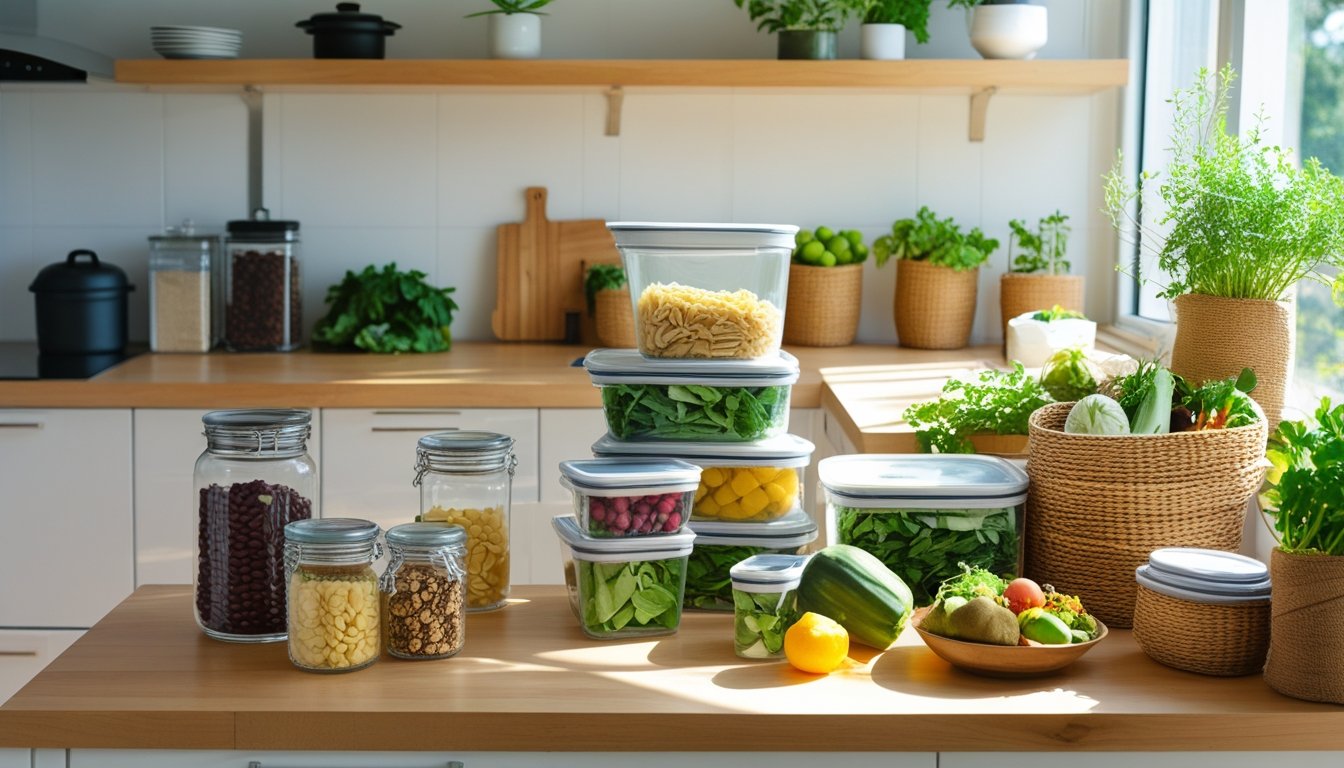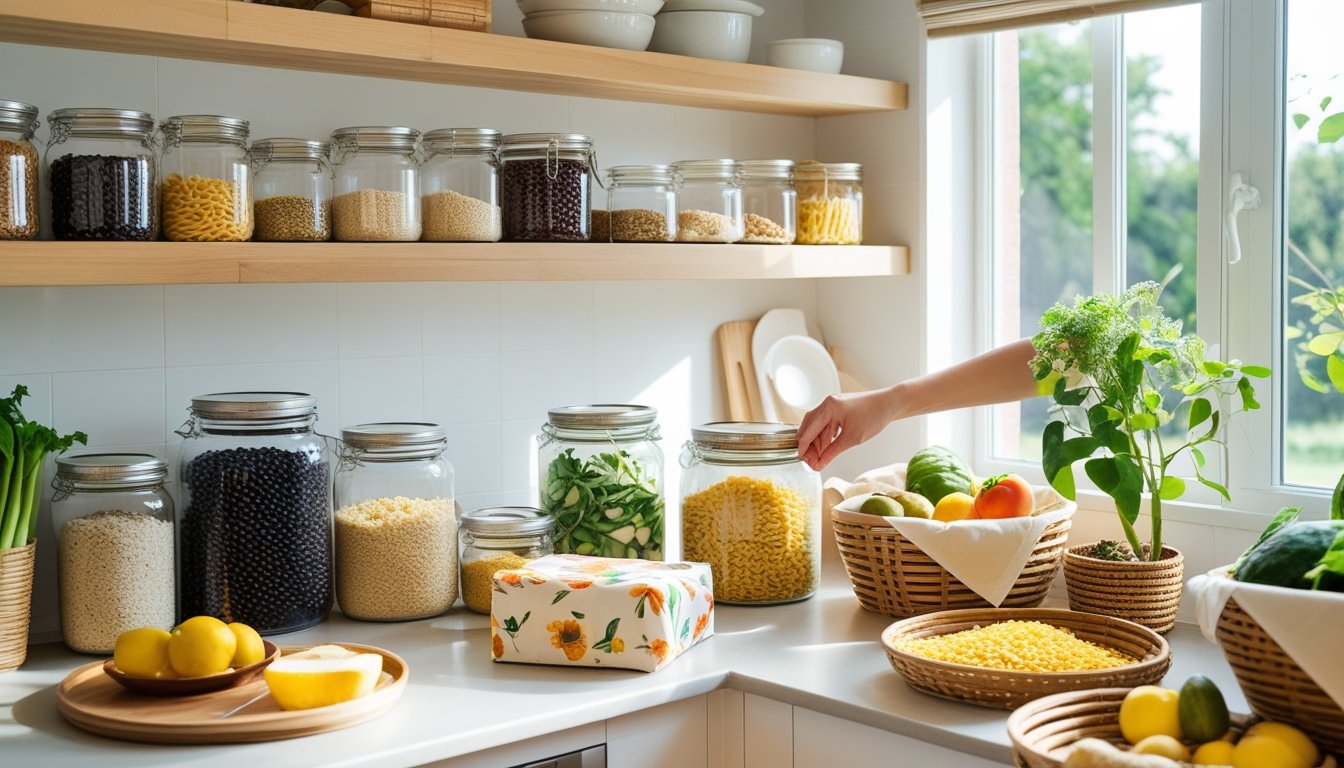Late updated: 14 May 2025 11:05
Written by: Sarah Hollister
Sustainable Ways To Store Food At Home: Eco-Friendly Solutions for Freshness
In a world where reducing our environmental footprint has never been more important, making our food storage solutions more sustainable is a step in the right direction. Not only does it help the planet, but it also extends the freshness of our food and supports a healthier lifestyle. There are many simple methods we can adopt, from choosing reusable silicone bags to using glass containers, all contributing to a greener kitchen.

Exploring eco-friendly food storage methods allows us to make an impact right from our kitchens. Options such as beeswax wraps and cotton produce bags replace single-use plastics, providing a practical yet sustainable alternative. This shift towards eco-conscious choices offers long-term benefits, both environmentally and economically, by reducing waste and packaging costs.
By embracing these sustainable practices, we can ensure that each meal we prepare not only nourishes us but also respects the planet. These everyday changes empower us to contribute to a more sustainable future while maintaining a functional and efficient kitchen.
Key Takeaways
- Glass and silicone containers are great sustainable options.
- Beeswax wraps and cotton bags reduce single-use plastics.
- Sustainable storage methods are eco-friendly and cost-effective.
Essential Principles of Sustainable Food Storage
To make our food storage practices sustainable, it's important to focus on minimising waste and preserving freshness, selecting eco-friendly materials, and thoughtfully extending the shelf life of various foods. Each of these principles contributes to reducing our carbon footprint and helping us save money while supporting a zero-waste lifestyle.
Minimising Food Waste and Preserving Freshness
We can significantly reduce food waste by correctly storing our groceries. Keeping grains and cereals in airtight containers is crucial, as it helps protect them from moisture and pests. Labelling containers with their contents and the storage date also aids in monitoring freshness.
Our freezers are valuable tools, allowing us to freeze perishable items and leftovers to extend their usability. Keeping perishable foods visible at the front of our fridge encourages consumption before they spoil. If perishables are easily accessible, we're more likely to use them, thus avoiding unnecessary waste.
Choosing Eco-Friendly Storage Materials
Selecting the right storage materials not only helps in preserving food but also has an environmental impact. We should opt for containers made from stainless steel, glass, or silicone, as these materials are more sustainable compared to plastic.
Stainless steel and glass containers are durable and reusable, reducing the need for single-use options. Silicone bags can replace disposable plastic bags, offering the same flexibility while being washable and long-lasting. Additionally, beeswax wraps can be a handy substitute for plastic wrap, providing a zero-waste option for covering leftovers and packing lunches.
Extending Shelf Life for Various Foods
Extending the shelf life of different foods requires specific storage strategies. For fruits and vegetables, refrigeration is essential, but some items like tomatoes and bananas fare better at room temperature. Understanding the unique storage needs of each type of produce helps in preserving their freshness for longer.
Cooled-down leftovers should be stored promptly in shallow containers within our fridge. This approach allows them to cool faster, reducing the risk of bacterial growth. Meanwhile, items like root vegetables should be kept in a dry, dark, and cool place. Using these techniques ensures our food stays fresh, reducing waste and helping us save money over time.
Practical Methods for Sustainable Food Storage at Home

Adopting sustainable food storage methods is essential for reducing waste and keeping produce fresh for longer. By choosing eco-friendly options, we can preserve food quality and minimise our environmental impact.
Using Glass Jars and Airtight Containers
Glass jars and airtight containers are excellent for sustainable food storage. Glass is reusable, recyclable, and free of harmful chemicals typically found in plastics. Airtight containers help prevent food from going stale or absorbing odours.
For storing grains, pulses, and dried herbs, choose clear glass jars, allowing us to quickly identify contents and reduce possible waste through forgotten items. Glass jars also help us effectively store dry foods and liquids due to their non-porous nature.
Employing Beeswax Wraps and Reusable Tea Towels
Replacing cling film and foil with beeswax wraps and reusable tea towels is a sustainable choice. Beeswax wraps are biodegradable and can be shaped around almost any food item or container, keeping our produce fresh while cutting down plastic waste.
Beeswax wraps are ideal for wrapping cheese, bread, and half-cut fruits. Reusable tea towels can cover bowls or wrap leafy greens. We should wash them between uses for hygiene, extending their lifespan.
Maximising the Efficiency of Your Refrigerator
To optimise our refrigerator, keep the temperature between 35°F to 40°F (1.5°C to 4°C). This range preserves freshness and reduces energy consumption. We can also group similar items to improve airflow and quickly access what we need.
Regularly checking the refrigerator allows us to consume food before spoilage. We can also reduce energy use by avoiding overloading and positioning items for better air circulation. Doing so keeps our refrigerator efficient and eco-friendly.
Optimal Storage of Fresh Produce and Herbs
To keep fresh produce and herbs lasting longer, proper storage is key. For instance, storing tomatoes and mushrooms in breathable containers prevents excess moisture buildup, preserving their condition. Separating bananas from other fruits slows down ethylene gas release, keeping produce fresher.
Leafy greens can be wrapped in tea towels. Storing herbs like parsley and cilantro in a jar with water, covering them loosely with a bag, extends their life. Paying attention to these details helps reduce waste significantly.
Freezing Leftovers and Bulk-Bought Items
We can make significant savings and reduce waste by freezing leftovers and bulk-bought items. Proper portioning allows us to defrost only what we need, ensuring food is used before spoilage.
Utilising transparent, stackable containers or freezer bags saves space and makes it easy to identify stored items. Labelling containers with contents and dates ensures we cycle through frozen goods effectively, before they lose their quality.
Home Grown Solutions: Grow and Store Your Own Food
Growing our own food can be a rewarding step towards sustainability. Cultivating herbs, tomatoes, or leafy greens at home reduces the environmental impact of food transport. It also gives us control over pesticides and fertilisers used.
Beyond consumption, we can store home-grown produce through canning, drying, or freezing for later use. This not only extends the availability of seasonal items but also strengthens our connection to the food we consume.
Frequently Asked Questions

In this section, we address common queries regarding sustainable methods for food storage. From material choices to practices that enhance food longevity, here are practical insights for maintaining an eco-friendly kitchen.
What are the most environmentally friendly food storage options?
Using reusable containers, like glass or stainless steel, significantly reduces waste. These alternatives are durable and can be used repeatedly, lowering our reliance on single-use plastics. Investing in high-quality, sustainable storage solutions can lessen environmental impact.
Which materials can be used as sustainable alternatives to plastic for food preservation?
Many eco-friendly options exist, including beeswax wraps, silicone bags, and cloth covers. These materials provide reliable preservation without contributing to plastic pollution. Selecting these options allows us to make more responsible choices.
Are glass containers a better choice than plastic for storing food sustainably?
Glass containers are often favoured due to their non-toxic nature and recyclability. Unlike plastic, glass doesn't leach chemicals, ensuring food safety. They're also odour-resistant and easy to clean, making them a practical and sustainable choice.
What can be used in place of cling film for covering food in an eco-conscious manner?
Beeswax wraps and silicone covers are effective substitutes for cling film. These options mould around food and containers much like cling film but are reusable and biodegradable, providing a greener choice for food covering.
How can I extend the shelf life of perishables using sustainable storage methods?
To maximise the freshness of perishables, proper storage temperatures and conditions are crucial. For instance, keep your fridge set between 1°C and 4°C. Utilising airtight containers and individually wrapping items like herbs can further prolong their lifespan.
What practices can be adopted to reduce food waste through effective, sustainable storage?
Being organised helps us to track food better. Labelling items with purchase dates prevents forgetting their freshness. Rotating older items to the front of the fridge ensures they're used before spoiling. Integrating these practices reduces wasted food significantly.
